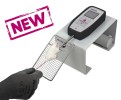Authors
A Razzaq, G Hussain, A Rasul, J Xu, Q Zhang
Lab
The Key Laboratory of Molecular Epigenetics of MOE, Institute of Genetics and Cytology, Northeast Normal University, Changchun, China
Journal
BMC Complementary Medicine and Therapies
Abstract
Background Peripheral nerve injury is a debilitating condition that may lead to partial or complete motor, sensory and autonomic function loss and lacks effective therapy until date. Therefore, it is quite imperative to explore impending remedies for rapid and accurate functional retrieval following such conditions. Natural product-based intervention can prove effective to facilitate the process of functions regain.
Methods Here, we investigated the effect of processed Strychnos nux-vomica seeds at a dose of 250_mg/kg body weight in a mouse model of induced Sciatic nerve lesion in promoting the recovery of the functions. A compression injury was induced in the Sciatic nerve of the right leg in the mice. Sensory function recovery was evaluated by hot-plate and formalin tests, whereas the motor function retrieval was assessed by measuring muscle grip strength, sciatic functional index, and muscle mass restoration. Oxidative stress and blood cell count were measured by biochemistry and haematological analyses.
Results This study indicates that Strychnos nux-vomica seeds enhance the rate of recovery of both sensory and motor functions. It helps restore the muscle mass, attenuates total oxidant status and enhances the total anti-oxidant capacity of the biological system. Moreover, the treated animals manifested an enhanced glucose tolerance aptitude and augmented granulocyte and platelet counts. Improved oxidant control, enhanced glucose sensitivity and amended granulocyte and platelet counts are likely to contribute to the advantageous effects of Strychnos nux-vomica, and warrant further in-depth studies for deciphering possible mechanisms and identification of active constituent(s) responsible for these effects.
Conclusion Strychnos nux-vomica seed offers functional recovery promoting effects following a mechanical injury to the Sciatic nerve and the possible reasons behind this effect can be reduced oxidative stress and improved glycaemic control. Further and detailed investigations can unravel this mystery.

 Pain - Thermal Allodynia / Hyperalgesia
Pain - Thermal Allodynia / Hyperalgesia Pain - Spontaneous Pain - Postural Deficit
Pain - Spontaneous Pain - Postural Deficit Pain - Mechanical Allodynia / Hyperalgesia
Pain - Mechanical Allodynia / Hyperalgesia Learning/Memory - Attention - Addiction
Learning/Memory - Attention - Addiction Physiology & Respiratory Research
Physiology & Respiratory Research
 Pain
Pain Central Nervous System (CNS)
Central Nervous System (CNS) Neurodegeneration
Neurodegeneration Sensory system
Sensory system Motor control
Motor control Mood Disorders
Mood Disorders Other disorders
Other disorders Muscular system
Muscular system Joints
Joints Metabolism
Metabolism Cross-disciplinary subjects
Cross-disciplinary subjects Happy new year 2025
Happy new year 2025 